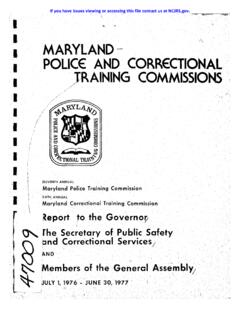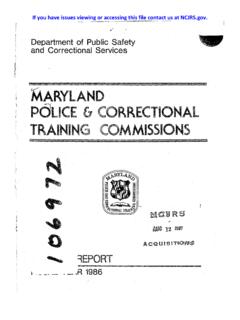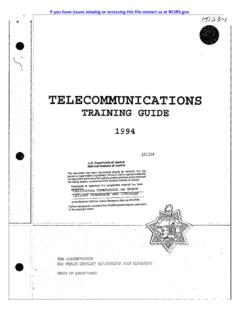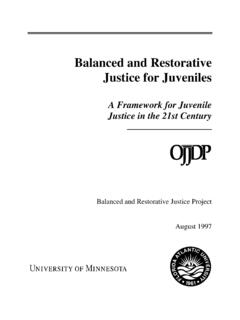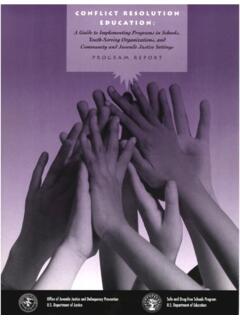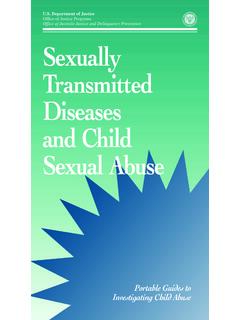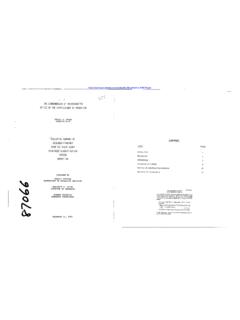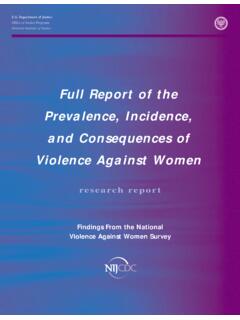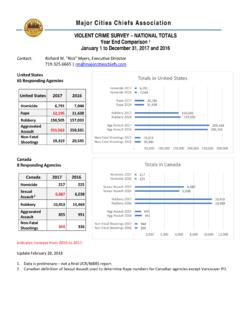Transcription of Sexual Assault Kit Backlog Study - ncjrs.gov
1 The author(s) shown below used Federal funds provided by the Department of Justice and prepared the following final report: Document Title: Sexual Assault Kit Backlog Study Author: Joseph Peterson, Donald Johnson, Denise Herz, Lisa Graziano, Taly Oehler Document No.: 238500. Date Received: June 2012. Award Number: 2006-DN-BX-0094. This report has not been published by the Department of Justice. To provide better customer service, ncjrs has made this Federally- funded grant final report available electronically in addition to traditional paper copies. Opinions or points of view expressed are those of the author(s) and do not necessarily reflect the official position or policies of the Department of Justice. This document is a research report submitted to the Department of Justice. This report has not been published by the Department. Opinions or points of view expressed are those of the author(s). and do not necessarily reflect the official position or policies of the Department of Justice.
2 Sexual Assault KIT Backlog Study . FINAL REPORT. 3-5-12. NATIONAL INSTITUTE OF JUSTICE. # 2006-DN-BX-0094. Joseph Peterson, Donald Johnson, Denise Herz, Lisa Graziano, and Taly Oehler California State University, Los angeles School of Criminal Justice & Criminalistics The authors also wish to acknowledge Steve Wilmes for his assistance in constructing project databases, and Ada Chan and Froseen Dahdouh for their diligence in collecting data from the laboratory files of the Los angeles Sheriff's Department (LASD) and the Los angeles Police Department (LAPD). The authors would also like to thank LASD and LAPD and the Los angeles County District Attorney's Office for their assistance and cooperation in collecting project data. This document is a research report submitted to the Department of Justice. This report has not been published by the Department. Opinions or points of view expressed are those of the author(s). and do not necessarily reflect the official position or policies of the Department of Justice.
3 Executive Summary Background Sexual Assault is one of the most serious crimes facing society and, over the past several decades, increasing attention has been paid to the proper collection of physical evidence from victims to document and reconstruct the crime, to identify the assailant, and to aid in the prosecution of the assailant. When victims report such offenses to the police and are examined at hospitals, medical personnel employ Sexual Assault kits and accompanying protocols to guide the collection of evidence from the victim. Sexual Assault kit (SAK) report forms also record important information from the victim about activities prior to, during and after the Assault . Given the likely transfer of biological secretions in such crimes, Sexual Assault kits and DNA. evidence have the power to verify the crime and pinpoint the identity of the assailant. The probative value of such scientific evidence, however, depends largely on the circumstances of the particular case, being pivotal in one instance and less important in another.
4 Although law enforcement agencies and hospitals have greatly improved and expanded procedures to gather Sexual Assault kit evidence, scientific resources and procedures to test such evidence have not kept pace. The National Institute of Justice staff, researchers and investigative journalists have uncovered the fact that backlogged and untested Sexual Assault kits (SAKs) are a major problem facing forensic crime laboratories and law enforcement agencies throughout the United States. The combined untested SAKs from the Los angeles Sheriff's Department (LASD) and Los angeles Police Department (LAPD) reached 10,895 cases in the fall of 2008. As the result of growing public concern, Human Rights Watch undertook a Study in Los angeles to document reasons behind the accumulation of these untested kits and found a number of organizational and resource deficiencies throughout the city and county. They were not crime laboratory backlogs per se but were untested kits held in police property rooms in cold storage, where investigators and prosecutors had not requested that the SAK be tested.
5 In 2009, however, the chief executives of Los Angles city and county law enforcement agencies announced that all backlogged kits would be tested, using outside private DNA testing laboratories. Study Objectives and Research Design The untested Sexual Assault kit problem in Los angeles , coupled with the fact that agencies had decided to test all such kits for the presence of DNA evidence, presented a unique research opportunity. The Sexual Assault Kit Backlog Project at California State University, Los angeles (CSULA) was funded by the National Institute of Justice (NIJ) in 2009 to accomplish four primary objectives: 1) evaluate the results of scientific tests performed by private laboratories on backlogged Sexual Assault kit (SAK) evidence from the LASD and LAPD crime laboratories, 2). review the Sexual Assault case processing literature and the role played by evidence and other factors in solving and prosecuting such cases; 3) determine the criminal justice dispositions of a sample of backlogged and non-backlogged cases before and after kit testing; and 4) identify principal case and evidence characteristics that could be used by forensic laboratories to evaluate and prioritize Sexual Assault evidence submitted to crime laboratories.
6 The accomplishment of such goals would aid all law enforcement agencies and associated crime laboratories about the value of testing backlogged Sexual Assault kits and to set guidelines for processing such evidence in the future. i This document is a research report submitted to the Department of Justice. This report has not been published by the Department. Opinions or points of view expressed are those of the author(s). and do not necessarily reflect the official position or policies of the Department of Justice. The backlogged cases in Los angeles were ones where investigators and prosecutors had concluded the case would not be helped by SAK testing and failed to submit them to the crime laboratory for analysis by November 2008. Project researchers from CSULA developed a research design to randomly collect a 20% sample (1,948 cases) of the 10,895 backlogged cases to be tested and to evaluate the scientific results achieved by private testing laboratories. Data collection focused on the respective agencies' crime laboratory files and the DNA reports submitted by outside private testing laboratories.
7 Data collection tools for this project focused on laboratory records and included key descriptive, investigative, dates of critical events, physical evidence, and analytical tests performed on the evidence. Records yielded information on DNA profiles and related CODIS submission activity. Researchers also took note of missing data in the laboratory files that often prevented a full accounting of forensic evidence processing. In addition, grant resources did not permit a complete review of detective case and prosecutorial records for these backlogged cases. Researchers were interested in both the results of the scientific testing of these backlogged cases, and if the test results had any appreciable effect on the criminal justice outcomes of these or other cases. To accomplish this latter objective, we compared the disposition outcomes of a smaller sample of backlogged cases with a sample of current non-backlogged cases where SAKs were being tested in the home crime laboratories.
8 While the backlogged sample represented cases that investigators (historically) thought would not benefit from SAK testing, the present day sample represented all cases where kits were collected and submitted to local crime laboratories for testing (current policy is to test all submitted SAKs.) The full report describes how these subsamples were chosen and tracked over a six-month period -- between receipt of laboratory test results and recording of criminal justice dispositions. In all, we tracked a random sample of 371 backlogged cases and 371 non-backlogged cases from both agencies for a total of 742 outcomes. Outcomes (arrest, charge, plea/trial, conviction, and sentence) were determined before and after testing occurred. The research design also included a review of the Sexual Assault case processing literature focusing on the role Sexual Assault kits, forensic evidence, and related information supplied by the victim played in such cases. It addressed the general theory of forensic evidence and how such evidence documenting the Assault and victim injuries, and other legal and extralegal evidence, may assist detectives and prosecutors in their investigation and prosecution of such acts.
9 In addition, researchers held focus groups with Sexual Assault investigators, prosecuting attorneys, and criminalists to discuss the role SAK evidence plays in resolving both stranger and non-stranger Sexual assaults. Such qualitative information helped to frame the data gleaned from laboratory files, and to gain first hand views of practitioners engaged in case level decisions. This Study was faced with similar challenges facing all researchers attempting to determine the role and impact of scientific evidence (from among a host of other case factors) in processing cases through progressive stages of the criminal justice process from arrest, through charging and adjudication, and concluding with sentencing. The fact this Study focused on older, backlogged Sexual Assault kits confronted more hurdles because of: 1) the fact that paper and computer files were located in numerous locations and computer files; 2) the absence of important data from files describing key variables; 3) the lack of resources to review all detective and prosecutor files ii This document is a research report submitted to the Department of Justice.
10 This report has not been published by the Department. Opinions or points of view expressed are those of the author(s). and do not necessarily reflect the official position or policies of the Department of Justice. associated with the kits; and 4) time constraints limited tracking of criminal justice dispositions of cases to six months after testing was completed. Findings Laboratory Results Data from tested SAKs were drawn from crime laboratory files and focused on victim and assailant demographic characteristics, the nature of the Sexual Assault , information collected by Sexual Assault nurses at the time of victim examination, laboratory test results, and the success of laboratories in uploading CODIS profiles and achieving case-to-case and offender hits. Ninety- three percent of victims were female, victims averaged years of age, and 39% were Hispanic/Latino. While female victims far outnumbered male victims by a ratio of 15 to 1, a significantly higher percentage of male victims were 13 or younger ( ) compared with females ( ).
